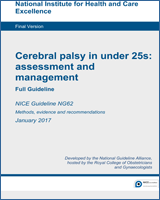From: 13, Management of eating, drinking and swallowing difficulties

Cerebral palsy in under 25s: assessment and management.
NICE Guideline, No. 62.
National Guideline Alliance (UK).
London: National Institute for Health and Care Excellence (NICE); 2017 Jan.
Copyright National Institute for Health and Care Excellence 2017.
NCBI Bookshelf. A service of the National Library of Medicine, National Institutes of Health.